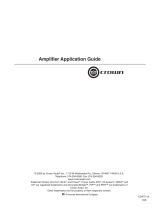
L-ACOUSTICS LA48a Manual V1.0 27/01/2003 1
TABLE OF CONTENTS
LIST OF FIGURES ................................................................................................................................... 2
LIST OF TABLES ..................................................................................................................................... 2
1. APPROVALS........................................................................................................................................ 3
2. WARNINGS......................................................................................................................................... 3
2.1 Explanation of Graphical Symbols ................................................................................................. 3
2.2 WARNING .................................................................................................................................... 3
2.3 CAUTION..................................................................................................................................... 3
2.4 Important Safety Instructions ........................................................................................................ 3
2.5 User Responsibility ........................................................................................................................ 4
2.5.1 Speaker Damage..................................................................................................................... 4
2.5.2 Speaker Output Hazard ......................................................................................................... 4
2.5.3 Radio Interference.................................................................................................................. 4
3. INTRODUCTION .............................................................................................................................. 6
3.1 Unpacking...................................................................................................................................... 6
3.2 Front Panel .................................................................................................................................... 6
3.3 Rear Panel...................................................................................................................................... 7
4. REAR PANEL FEATURES ................................................................................................................... 8
4.1 Impedance Matching (MLS switch)................................................................................................ 8
4.1.1 MLS Technology Background.................................................................................................9
4.2 Clip Limiter.................................................................................................................................... 9
5. INSTALLATION................................................................................................................................ 10
5.1 Mounting...................................................................................................................................... 10
5.2 Cooling ........................................................................................................................................ 10
5.3 Operating Voltage ....................................................................................................................... 11
5.3.1 Denmark............................................................................................................................... 11
5.3.2 Switzerland ........................................................................................................................... 11
5.4 Grounding.................................................................................................................................... 11
5.5 Power Consumption ................................................................................................................... 12
5.6 Heat Power Calculation .............................................................................................................. 13
5.7 Gain and Sensitivity...................................................................................................................... 13
6. CONNECTIONS .............................................................................................................................. 14
6.1 Input Connections ....................................................................................................................... 14
6.1.1 Balanced Inputs..................................................................................................................... 14
6.1.2 Unbalanced Inputs ................................................................................................................ 15
6.2 Connecting Speakers................................................................................................................... 15
7. OPERATION..................................................................................................................................... 16
7.1 Operation Modes ........................................................................................................................ 16
7.1.1 Stereo Mode......................................................................................................................... 16
7.1.2 Tandem Mode ...................................................................................................................... 17
7.1.3 Bridged Mono Mode ............................................................................................................ 17
7.2 Operating Precautions................................................................................................................. 17
7.3 Powering Up – Soft Start............................................................................................................. 18
7.4 Input Attenuators ........................................................................................................................ 18
7.5 Indicators ..................................................................................................................................... 18
8. PROTECTION FEATURES............................................................................................................... 19
8.1 Clip Limiter.................................................................................................................................. 19
8.2 Thermal Protection ..................................................................................................................... 19
8.3 VHF Protection............................................................................................................................ 19
8.4 Short Circuit Protection .............................................................................................................. 19
8.5 Automatic Fuse Saver, AFS
tm
-Limiter .......................................................................................... 20
8.6 AC Mains Voltage Protection ...................................................................................................... 20




















